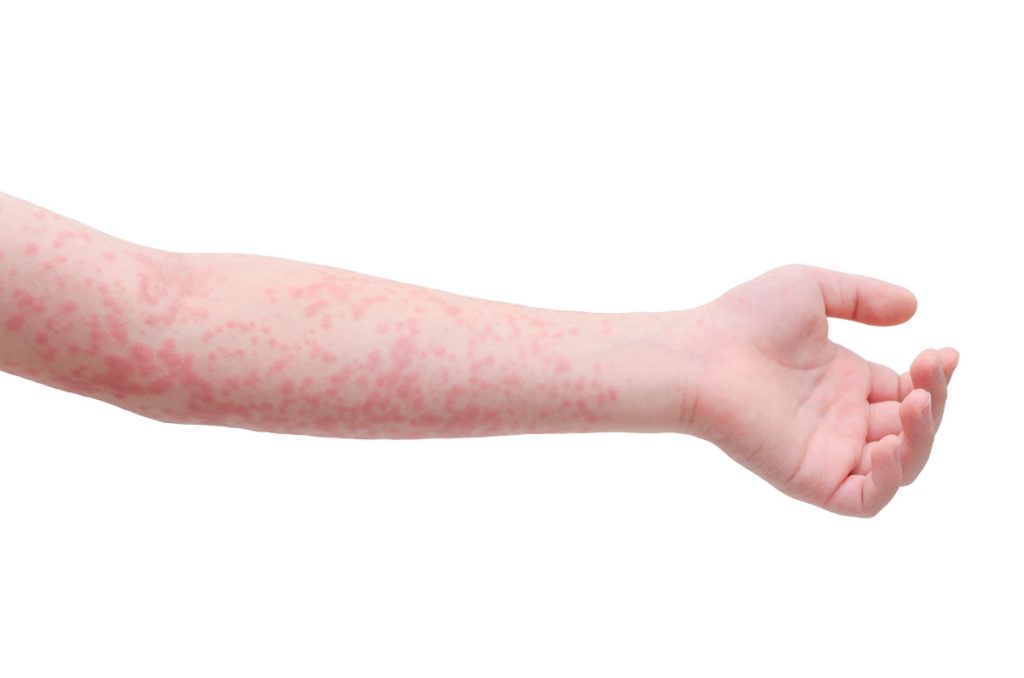
Adult-onset Still’s disease (AOSD) is a rare, systemic inflammatory disorder of unknown etiology. Its name comes from another condition, Still’s disease, which is also known as Systemic Juvenile Idiopathic Arthritis (JIA). Systemic JIA is only diagnosed in children while AOSD can only be diagnosed in adults. AOSD is a challenging diagnosis due to its rarity and nonspecific symptoms. Early recognition by our healthcare professionals and prompt initiation of appropriate treatment are critical to optimize patient outcomes and manage potential complications.
Contents
Clinical Presentation:
AOSD often presents with a characteristic triad of symptoms:
- Triad:
- Fever: High spiking fevers (> 102.2°F) daily or twice daily, typically in the afternoon or evening.
- Rash: Evanescent, salmon-pink maculopapular rash appearing and disappearing with fever spikes.
- Arthritis: Polyarticular, migratory joint pain, stiffness, and swelling lasting at least two weeks.
- Additional features:
- Muscle aches, fatigue, sore throat, lymphadenopathy, and serositis may occur.
- Elevated white blood cell count, high ferritin levels (> 1000 ng/mL), and C-reactive protein are common laboratory findings.
Diagnosis:
There is no single definitive test that can diagnose AOSD, but a combination of factors help us reach an accurate diagnosis. Diagnosis also requires that autoimmune diseases like rheumatoid arthritis, systemic lupus erythematosus, and infections are ruled out.
- ACR (American College of Rheumatology) criteria: Requires meeting at least 5 of the following 7 criteria:
- Fever lasting at least 2 weeks
- Arthralgia or arthritis lasting at least 2 weeks
- Rash during fever spikes
- Sore throat with no pharyngeal exudate
- Lymphadenopathy (enlarged lymph nodes) (≥ 1.5 cm)
- Elevated white blood cell count (> 10,000/μL)
- Elevated ferritin (> 400 μg/L)
Treating Adult Onset Still’s Disease
Adult-onset Still’s disease (AOSD) is a rare inflammatory condition characterized by high fevers, joint pain, and a distinctive salmon-colored rash. While there’s no cure, various treatment approaches can help manage symptoms and improve quality of life.
Pharmacological management:
- First-line:
- Nonsteroidal anti-inflammatory drugs (NSAIDs): Commonly prescribed oral medications such as Ibuprofen, Diclofenac, Indomethacin, Celebrex, Meloxicam.
- Corticosteroids (Prednisone, Methylprednisolone, Dexamethasone): Medications that work by suppressing the immune response in AOSD.
- Second-line:
Disease-modifying antirheumatic drugs (DMARDs)
- Methotrexate (Rheumatrex, Trexall): An antimetabolite with anti-inflammatory and immunosuppressive properties.
- Azathioprine (Imuran): An immunosuppressant that suppresses the immune system by interfering with purine synthesis
- Mycophenolate mofetil (Cellcept): An immunosuppressant that inhibits the proliferation of T and B lymphocytes.
- Third-line:
Biologic agents like TNF-alpha inhibitors and IL-1 inhibitors may be considered in refractory cases.
- Tumor necrosis factor (TNF)-alpha inhibitors (Humira, Enbrel, Cimzia, Remicade, Simponi): Intravenous or subcutaneous medication that suppresses the physiologic response to tumor necrosis factor, which is part of the inflammatory response.
- Interleukin-1 Inhibitors (Anakinra, Ilaris): Subcutaneous medication that suppresses the physiologic response to Interleukin-1, which is part of the inflammatory response.
Prognosis:
AOSD can be a chronic and relapsing-remitting disease with variable clinical courses. Early diagnosis and treatment are crucial to prevent joint damage and improve long-term outcomes.
References
- Uptodate.com/contents/clinical-manifestations-and-diagnosis-of-adult-onset-stills-disease
- Pouchot J, Sampalis JS, Beaudet F, et al. Adult Still’s disease: manifestations, disease course, and outcome in 62 patients. Medicine (Baltimore) 1991; 70:118. https://pubmed.ncbi.nlm.nih.gov/2005777/
- Efthimiou P, Paik PK, Bielory L. Diagnosis and management of adult onset Still’s disease. Ann Rheum Dis 2006; 65:564. https://pubmed.ncbi.nlm.nih.gov/16219707/






